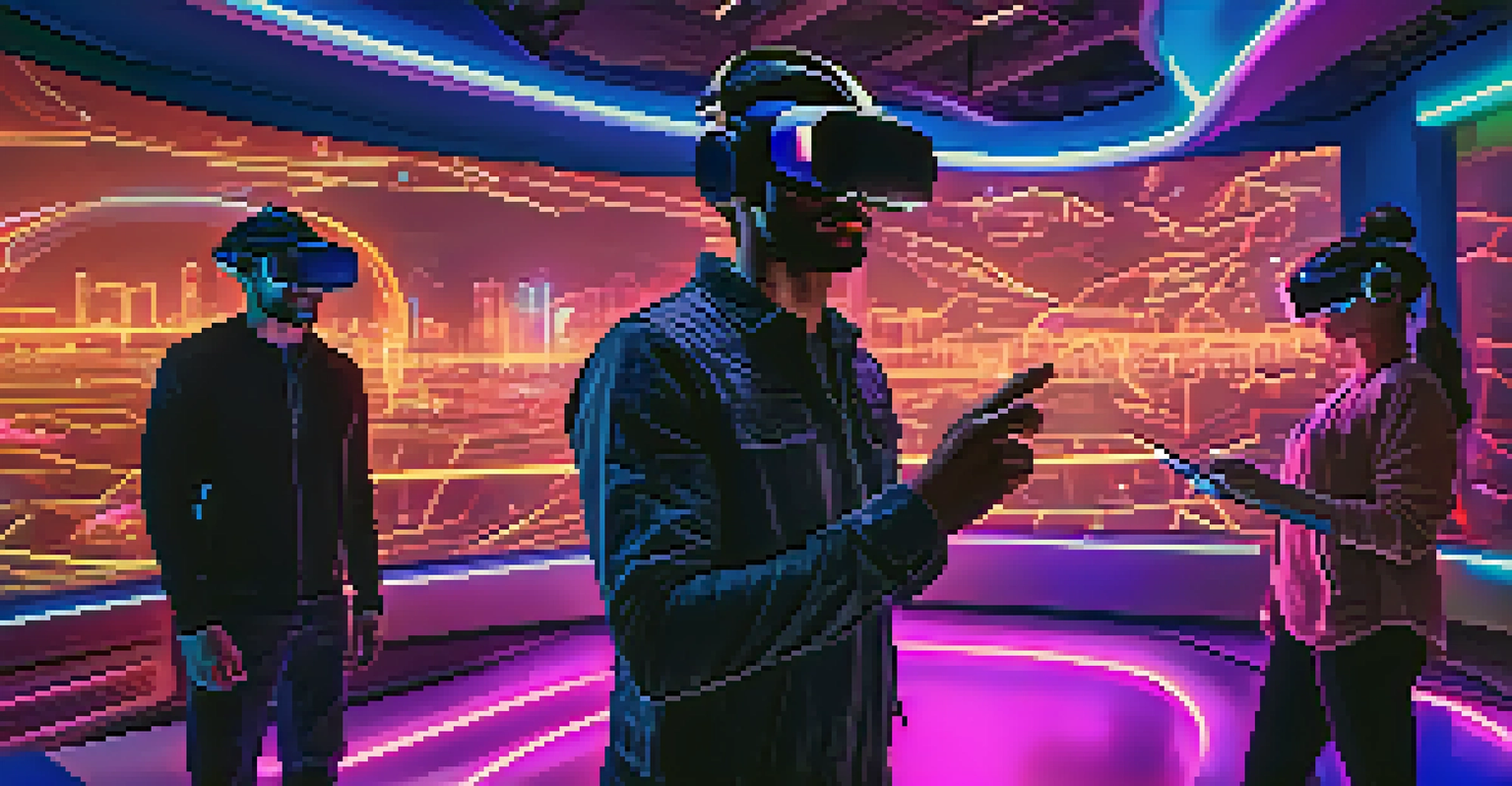The Science of VR: How It Affects Our Brain and Perception

What is Virtual Reality and How Does It Work?
Virtual Reality, or VR, immerses users in a computer-generated environment that feels real. Using headsets and sensors, it tricks the brain into believing it's experiencing a different reality. This technology can range from simple simulations to highly detailed worlds that engage our senses.
Virtual reality is not just a new technology; it's a new medium for storytelling, connection, and understanding.
At its core, VR relies on a blend of visual and auditory stimuli to create an immersive experience. When you put on a VR headset, your brain receives 3D images and spatial audio that mimic real-world sensations. This combination can transport you anywhere from a serene beach to a bustling city, making it a powerful tool for entertainment and education.
The magic of VR lies in its ability to engage our natural instincts. As we explore these virtual environments, our brains respond in ways similar to how they would in the real world, leading to heightened emotions and reactions. This unique engagement is what makes VR so captivating and effective.
The Brain's Response to Virtual Environments
When we step into a virtual world, our brains react almost instinctively. Studies show that VR can activate areas of the brain associated with real-life experiences, like the amygdala, which processes emotions. This means that the feelings we experience in VR can be just as intense as those in reality.

For instance, a person might feel fear while facing a virtual monster, even though they know it's not real. This phenomenon occurs because our brain treats VR stimuli similarly to actual situations, prompting physical and emotional responses. It's not just play; it's a genuine experience that can be harnessed for various applications.
VR Immersion and Emotional Impact
Virtual Reality engages users by immersing them in lifelike experiences that evoke strong emotional responses.
Interestingly, this response can be used for therapeutic purposes, helping individuals confront fears in a controlled environment. By gradually exposing someone to their fear through VR, they can learn to manage their reactions, leading to significant improvements in anxiety and phobias.
How VR Influences Our Perception of Reality
VR can significantly alter our perception of reality by immersing us in experiences that challenge our senses. For example, virtual environments can create the illusion of depth and scale that may not exist in the real world. This manipulation of perception allows users to experience scenarios they may never encounter otherwise.
The real world is a piece of virtual reality that we have created ourselves.
One fascinating aspect of VR is its ability to create a sense of presence, making users feel as if they are genuinely 'there.' This sense of presence can lead to changes in behavior and attitude, demonstrating how powerful our perceptions can be in shaping our actions. It’s as if we’re living through a new lens, reshaping our understanding of what’s possible.
As we spend more time in these virtual spaces, we might even find our perceptions of physical reality shifting. Think of it like this: if you regularly navigate through a virtual forest, you may begin to notice details in a real forest that you previously overlooked, showcasing how VR can enhance our awareness of the world around us.
The Role of Emotion in VR Experiences
Emotion plays a crucial role in how we interact with VR. Whether it's excitement, fear, or nostalgia, these feelings can enhance our engagement with the virtual world. When developers design VR experiences, they often aim to evoke strong emotional reactions to create memorable and impactful moments.
For instance, a VR game that places you in a thrilling chase can trigger adrenaline, making you feel alive and invested in the outcome. This emotional connection can lead to a deeper immersion, as users become more attached to the experiences, characters, and narratives presented in the virtual realm.
Memory Formation in VR
Experiences in VR can create vivid memories that are often more impactful than those formed in real life.
Moreover, harnessing emotions in VR can be beneficial in therapeutic settings. By evoking specific feelings, therapists can guide patients through emotional challenges, providing a safe space for exploration and healing. This intersection of emotion and VR opens up new avenues for treatment and personal growth.
Virtual Reality and Memory Formation
VR has a unique ability to create powerful memories, often more vivid than those formed in the real world. When we experience something in VR, our brains encode the information in a way that feels deeply personal and significant. This is partly due to the emotional responses triggered during the experience.
For example, participating in a virtual training simulation can lead to better retention of the information compared to traditional methods. The hands-on nature of VR, paired with the emotional engagement, helps solidify those memories in our minds, making it a useful tool for learning and development.
Additionally, VR can be a compelling way to revisit memories. Imagine putting on a headset and stepping back into a cherished moment from your past. This ability to relive experiences enhances our understanding of memory and the ways we connect with our personal histories.
Potential Risks of VR on Mental Health
While VR offers exciting possibilities, there are potential risks for mental health that should not be overlooked. For some individuals, prolonged exposure to virtual environments can lead to feelings of disconnection from reality, known as depersonalization. This condition can create challenges in everyday life, blurring the lines between the virtual and real.
Moreover, VR can trigger intense emotions that may be difficult for some users to process, especially in therapeutic settings. If not managed properly, these experiences could lead to heightened anxiety or distress, particularly for those with pre-existing mental health conditions. Hence, it's crucial to approach VR use with care and intention.
Potential Mental Health Risks
While VR offers exciting possibilities, prolonged use may lead to disconnection from reality and heightened anxiety for some individuals.
To mitigate these risks, developers and therapists must prioritize user safety and provide appropriate guidelines. This includes monitoring usage time and ensuring that experiences are tailored to individual needs, thereby promoting a healthier relationship with VR technology.
The Future of VR and Its Impact on Society
The future of VR is bright, with potential applications extending beyond entertainment into education, healthcare, and beyond. As technology advances, we can expect even more immersive experiences that could reshape how we learn, work, and socialize. Imagine attending a virtual classroom or participating in a remote team meeting as if you were all in the same room.
Furthermore, VR could revolutionize therapy and rehabilitation by creating controlled environments for patients. From physical therapy to mental health treatment, the possibilities are vast, offering innovative ways to enhance recovery and well-being. As we embrace these advancements, we may find new pathways to connect with others and ourselves.

Ultimately, the impact of VR on society will depend on how we choose to harness this technology. By focusing on ethical considerations and user well-being, we can ensure that VR serves as a tool for positive change, fostering connection and understanding in our increasingly digital world.